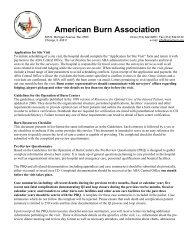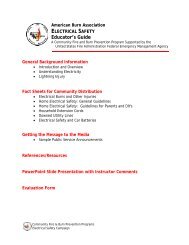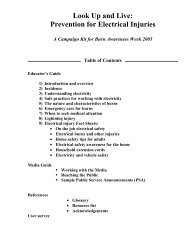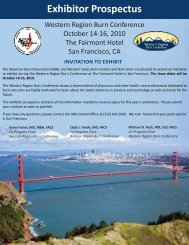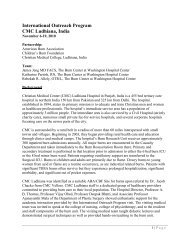Residential Fire Sprinklers - American Burn Association
Residential Fire Sprinklers - American Burn Association
Residential Fire Sprinklers - American Burn Association
- No tags were found...
You also want an ePaper? Increase the reach of your titles
YUMPU automatically turns print PDFs into web optimized ePapers that Google loves.
<strong>Residential</strong> <strong>Fire</strong> <strong>Sprinklers</strong>
America’s s <strong>Fire</strong> Problem• Most fires and burn injuries occur in the home•80% of all fire deaths occur at homeAnnually in US:• 405,000 residential fires• 18,600 injuries and 3,600 deaths fromresidential fires•$4.7 billion in property lossREF: Smith LE, <strong>Fire</strong> Incident Study CPSC 1995
America’s s <strong>Fire</strong> Problem• The number of fires and the numberof fatal fires has trended down sincethe 1970’s•Improved building codes•Smoke alarms
Smoke Alarms•94% of all US homes have at least onesmoke alarm•Percentage unchanged over last 10years and probably at saturation point•The 6% of homes without a smoke alarmaccount for 77% of all annual firedeathsREF: Smith, LE et al: NFPA Journal 1997 Sept-OctPetraglia, JS: NFPA Journal 1991 March-AprilAhrens, M: US experience with smoke alarms and other fire detection/alarm equipment, NFPA, 2004
Smoke Alarms•59% of homes with smoke alarms have onlyone alarm•Up to 32% do not alarm in presence ofsmoke•Millions of smoke alarms are beyond theexpected 10 year service life•Many are nonfunctional because of deador missing batteries
Smoke Alarms•Smoke alarms detect rather than fightfires•<strong>Fire</strong> death high risk groups: elderly,children, mobility challenged,intoxicated•Knowing that the house is on fire is notthe same as being able to escape the fire•Smoke detectors do not help the peoplewho need them the most
<strong>Residential</strong> <strong>Fire</strong> <strong>Sprinklers</strong>•Complement the protection of smoke alarms•Both detect and fight fire•Used in commercial structures for over 100years (Property(Safety)•With exception of terrorist attacks, there hasnever been a multiple-fatality fire in any fullysprinklered building•USFA funded development of residentialsprinkler systems in 1970’s s (Life(Safety)
<strong>Residential</strong> <strong>Fire</strong> <strong>Sprinklers</strong>•Fast-reacting (early fire control with lesswater)•Intended for one head per room installation•Special water distribution pattern•Original design: one head per 144 square feet•New designs: one head per 400 square feet
<strong>Residential</strong> <strong>Fire</strong> <strong>Sprinklers</strong>Home <strong>Fire</strong> Safety Program• Smoke alarms• Carbon monoxide detectors• Portable fire extinguishers• Escape plan• <strong>Residential</strong> fire sprinklers
Smoke Alarms•May be battery powered, line powered orboth•Can be designed to activate one alarm, allsmoke alarms at once or at a centralmonitoring station•Ionization smoke alarms•Photoelectric smoke alarms
Smoke Alarms•Installation should meet requirements ofNFPA 72•New construction: alarms in each bedroom,outside the bedrooms and a minimum of onealarm per level of house•Existing construction: alarm installationoutside of bedrooms and on each level of thehouse•At least 20 feet away from cooking areas
Smoke Alarms•Test each alarm at least once a month•Replace batteries twice a year, except inalarms designed to use 10-year batteries•Replace smoke alarms every 10 years•Special alarms are available for the hearingimpaired. These may strobe, vibrate or shakepillows•Special alarms are available for youngchildren which allow parents to recordescape instructions in their own voices
Smoke AlarmsDo Not•Detect carbon monoxide•Extinguish fires
Carbon Monoxide• A colorless, odorless, tasteless poisonousgas that is not detected by human senses•Produced in fires•Produced by vehicle and generator engines•Malfunction of fireplaces natural gas /propane fired heaters or hot water heatersespecially if flue is blocked•Malfunction of kerosene heaters
Carbon Monoxide Detectors• May be battery powered, line powered orboth•Installation should follow NFPA 720•Detectors should comply with UL Standard2034•Do not detect smoke•Install both smoke alarms and carbonmonoxide detectors in every home
Portable <strong>Fire</strong> Extinguishers• Home use by non-professionals iscontroversial• <strong>Fire</strong> extinguishers are an effectivetool only if you are trained to usethe correct type of fire extinguisherfor the type of fire you encounter.•Otherwise:get out, stay out, andcall 911.
Home <strong>Fire</strong> SafetyEscape Plans• Identify 2 ways out of every room• Crawl low under smoke• Feel door with back of hand• Designate a safe meeting place• Call 911 from neighbors house• Once out, stay out
Home <strong>Fire</strong> SafetyEscape Plans• Escape plans work best if they areregularly practiced• Home escape drills• Be realistic (at night, lights off)• Change drills to block some exits,allowing practice of alternate escaperoutes
<strong>Residential</strong> <strong>Fire</strong> <strong>Sprinklers</strong>•The ONLY component of a home fire safetyprogram that can both detect and fightthe fire•Automatic <strong>Fire</strong> <strong>Sprinklers</strong> areindividually heat-activated activated devices thatare attached to a network of piping withwater under pressure
<strong>Residential</strong> <strong>Fire</strong> Sprinkler SystemsWater Supply• Street main which already supplies domesticwater• May need to increase size of home watermain or install second water meter• Well water: will require storage tank andpressurizing device• 300 gallon tank will meet the 10- minuteflow requirement in most cases
<strong>Residential</strong> <strong>Fire</strong> Sprinkler SystemsPlumbing• Check valve (backflow valve) preventssprinkler system water from flowing back intodomestic water supply• Riser: control center of the system• Cross members: pipes that distribute water• Plumbing may be plastic (CVPC) instead ofmetal
<strong>Residential</strong> <strong>Fire</strong> Sprinkler SystemsAlarms• A water-flow alarm sounds when water isflowing in the system, implying that a fireis present• Should be audible in all living areas andoutside of the house• May be connected to central stationmonitoring to facilitate <strong>Fire</strong> Departmentnotification
<strong>Residential</strong> <strong>Fire</strong> Sprinkler Heads•Fast-reacting (early fire control with lesswater)•Intended for one head per room installation•Special water distribution pattern•Original design: one head per 144 square feet•New designs: one head per 400 square feet
<strong>Residential</strong> <strong>Fire</strong> Sprinkler Systems<strong>Residential</strong> Sprinkler Heads• Contain a fusible link or glass bulb whichmelts or shatters when ambient temperaturesof 135 o F to 165 o F are reached• Normally flows 18 gallons of water perminute at a minimum pressure of 7 pounds persquare inch•Deflector designed to allow water to coverall areas of the room
<strong>Residential</strong> <strong>Fire</strong> <strong>Sprinklers</strong>How do <strong>Residential</strong> <strong>Fire</strong> <strong>Sprinklers</strong>work?Cap sealGlass bulbDeflector
<strong>Residential</strong> <strong>Fire</strong> <strong>Sprinklers</strong>• When pre-set temperature isreached, the fusible link burstallowing the water to flow through thedeflector.
<strong>Residential</strong> <strong>Fire</strong> Sprinkler Heads• Available in many styles andcolors to match room décord• Some styles have a cover plate tohide the sprinkler head
<strong>Residential</strong> <strong>Fire</strong> Sprinkler SystemsDesign and Installation• By knowledgeable, licensed and experiencedsprinkler contractors• In compliance with national standards, state andlocal laws and building codes• NFPA 13- Installation of Sprinkler Systems• NFPA 13D- Installation of sprinkler systems in 1and 2 family dwellings• NFPA 13R- installation of sprinkler systems inresidential structures up to and including 4stories in height
<strong>Residential</strong> <strong>Fire</strong> Sprinkler SystemsEffectiveness• In 100 years of sprinkler experience before b9/11/2001, there has never been a major (>3 persons)loss-ofof-life fire in any fully sprinklered building•Napa CA, Cobb County GA, Prince George’s s County,MD- all have residential sprinkler legislation andnone have experienced a single fire fatality in anysprinkler-equipped equipped residence•Scottsdale AZ: <strong>Fire</strong> sprinkler legislation creditedwith saving up to 52 lives since enacted in 1985
<strong>Residential</strong> <strong>Fire</strong> Sprinkler SystemsEffectiveness•NFPA: Average fire property loss is 38% lower inhomes with fire sprinklers• House fires in Scottsdale AZ:Average property loss with <strong>Fire</strong> sprinklers = $2166Average loss without sprinklers = $45,019
<strong>Residential</strong> <strong>Fire</strong> <strong>Sprinklers</strong>Advantages to Developers and Builders:• Building code alterations and constructiontradeoffs• Reduced fire-retarding retarding requirements of wallsand doors = reduced construction costs• A value-added added feature of new homes• Increased housing density• Decreased street width requirements
<strong>Residential</strong> <strong>Fire</strong> <strong>Sprinklers</strong>Advantages to the Homeowner:•Gets water on the fire immediately•Not dependent on <strong>Fire</strong> Department response time•May control fire at earlier stage with lesswater•Provides extra time for escape of occupants•Reduction in insurance premiums
<strong>Residential</strong> <strong>Fire</strong> <strong>Sprinklers</strong>Advantages to the <strong>Fire</strong> Department:•Severity of residential fires is reduced•May delay flashover conditions•May delay or obviate need for interior rescue•Potentially reduces or avoids firefighterinjury•Allows overburdened FD to do more with less
<strong>Residential</strong> <strong>Fire</strong> <strong>Sprinklers</strong>Advantages to the Community:•Allows increased property density•Slows the rate of <strong>Fire</strong> Department growth as thecommunity expands•Allows reduced street widths•Allows longer cul-dede-sac lengths•Reduces number of hydrants needed•Simplifies building codes
<strong>Fire</strong> Sprinkler Myths• There are many misconceptions surroundingresidential fire sprinkler systems•These misconceptions hinder homeowneracceptance of residential fire sprinkler systems•NONEof the following myths are true:
<strong>Fire</strong> Sprinkler Myths-<strong>Sprinklers</strong> cause water damage• Because sprinklers activate early in thecourse of a fire, the fire can often becontrolled with much less water• Waterflow alarm notification of CentralStation = earlier notification of <strong>Fire</strong> Dept• <strong>Fire</strong> sprinklers flow 18 gallons per minute.<strong>Fire</strong> hoses flow 300 gallons per minute18 gallons @ 10 minutes = 180 gallons300 gallons @ 10 minutes = 3000 gallons
<strong>Fire</strong> Sprinkler Myths-Installation is expensive• The cost of fire sprinkler installation in newconstruction is $1.00 to $1.50 per square foot• Retrofit costs in existing construction is 20-30% higher• In new construction, the cost of firesprinkler installation is approximately the sameas the cost of installing wall-toto-wall carpetingor the cost of installing lawn sprinklers
<strong>Fire</strong> Sprinkler Myths-When one head activates,all heads activate• Sprinkler heads operate independently of each other• Sprinkler heads are designed to activate only whenambient heat exceeds 135-165165 o F• Sprinkler heads are designed to be installed oneper room. If the fire is confined to one room, onlyone head will activate• Early activation of one sprinkler headoften keeps the fire from spreading
<strong>Fire</strong> Sprinkler Myths-Sprinkler systems malfunctionor leak• Factory Mutual estimates the incidence offalse activation as one activation in 16 millionsprinkler heads per year• Because there is no significant wear and tear,the leak rate of residential sprinkler plumbingis significantly lower than the remainder of theplumbing in the home
Summary<strong>Residential</strong> <strong>Fire</strong> <strong>Sprinklers</strong>• Are the only home fire safety device thatboth detects and controls fires• Are highly effective in reducing injury anddeath rates and property loss• Are reliable• Have installation costs comparable to wall-toto-wall carpeting and lawn sprinklers• Should be in both your communityand in your home
For Further Information:Contact the<strong>American</strong> <strong>Burn</strong> <strong>Association</strong>1-800 548 BURNwww.ameriburn.org




